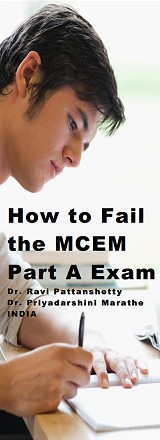EmergencyMedicine.in
EMinside
Favorites
Recommended
ATLS India - Advanced Trauma Life Support
 atls.in
atls.in 
American College of Emergency Physicians
 acep.org
acep.org
College of Emergency Medicine, United Kingdom
 rcem.ac.uk
rcem.ac.uk
Australasian College of Emergency Emergency Medicine
 acem.org.au
acem.org.au
 atls.in
atls.in 
American College of Emergency Physicians
 acep.org
acep.orgCollege of Emergency Medicine, United Kingdom
 rcem.ac.uk
rcem.ac.ukAustralasian College of Emergency Emergency Medicine
 acem.org.au
acem.org.auLet Others Know
Verified Site
Visitor Stats
Articles Hierarchy
MCEM Part A Questions
January 2006 Part A MCEM Questions
Part A consists of 50 Questions with 4 stems each. Each stem needs to marked as either TRUE or FALSE. There is no negative marking. Time duration is 2 hours.
1) In a patient on phenytoin having seizures
a) Lorazepam is the drug of choice.
b) A loading dose of phenytoin is an acceptable second alternative.
c) Phenytoin plasma concentration follows a linear relationship with dosage.
d) Paraldehyde is contraindicated in this patient.
2) About Hepatitis B virus
a) 10% will become carriers.
b) Commonly spreads through the feco-oral route.
c) HbeAg signifies high infectivity.
d) HbcAg detects immunity.
3) About rhabdomyolysis
a) Aim to maintain urine output at 2ml/kg/hr.
b) Feature of hypothermia
c) Urine dipstick can be used to rule out myoglobin in urine.
d) ?
4) About Cocaine
a) Inhibits norepinephrine reuptake at nerve endings.
b) Causes dilated cardiomyopathy.
c) Can cause coronary disease & myocardial infarction.
d) ?
5) About Gastroenteritis
a) Rotavirus can spread through respiratory route.
b) Norwalk virus is a common etiologic agent in institutions.
c) Abdominal pain is a predominant feature in rotavirus infections.
d) ?
www.emergencymedicine.in
6) Patient has a hot swollen knee, you have diagnosed as gout. He has taken amlodipine, perindropil & warfarin
a) Allopurinol should be started early & continued.
b) NSAIDs can be given to relieve pain.
c) Prophylactic antibiotics are required if joint is aspirated.
d) The drugs which the patient is recieving are the cause of increased uric acid levels.
7) About Ocular muscles
a) Superior oblique moves the eye down & out.
b) Inferior oblique moves the eye up & out.
c) IV nerve supplies lateral rectus.
d) ?
8) About Intravenous fluids
a) 1 litre of Normal saline contains 130mEq of sodium.
b) 1 litre of 8.4% sodium bicarbonate contains 1000mEq of sodium.
c) 1 litre of 5% dextrose contains 5000mg of glucose.
d) 1 litre of Hartmann's solution contains 2mmol of Calcium.
9) About platelets
a) Clopidogrel inhibits GpIIB-IIIA receptors.
b) Aspirin inhibits platelet cyclooxygenase irreversibly.
c) Platelets are activated by thrombin.
d) ?
10) About Cardiac enzymes
a) Troponins are accurate tests for MI within 6 hours.
b) Troponins have greater than 98% sensitivity for MI after 12 hours of onset of chest pain.
c) Troponins are not reliable enough to detect reinfarction within 2 weeks.
d) They can be used reliably to stratify risk in patients with unstable angina.
www.emergencymedicine.in
11) About Gaussian distribution
a) It can be skewed left or right.
b) 95% of subjects fall within +/- 2.5 SD
c) Median is the mode.
d) It is a type of frequency distribution.
12) Comparing D-Dimer levels to gold standard CT angiogram of chest
CT-Angiogram | + | - |
D-Dimer >0.5 | 78 | 20 |
D-Dimer <0.5 | 02 | 80 |
a) Sensitivity is 78/80.
b) If sensitivity is >0.85, this is an appropriate test.
c) Specificity is the number of patients detected negative who have the disease.
d) The post predictive value varies with the population to which its applied to.
13) About Tuberculosis
a) Initial infection is via respiratory droplets.
b) 90% of infected patients develop disease.
c) Miliary tuberculosis is via blood borne infection.
d) Caseous granulomas are frequently seen in the lower & basal regions of the lungs.
14) About Ventilation
a) In COPD FEV1/FVC is >0.5
b) Peak expiratory flow rate is an indirect measurement of small airway resistance.
c) Spirometry is better than ABG at assessing strength of respiratory muscles.
d) Pulse oximetry is a reliable indicator of adequate ventilation.







